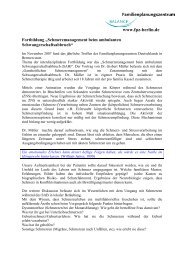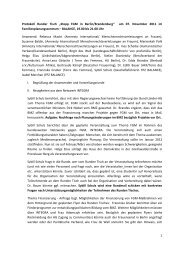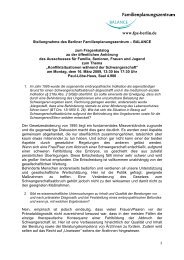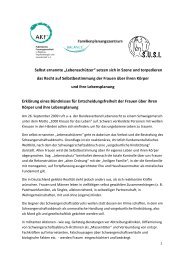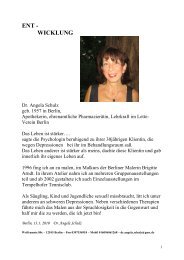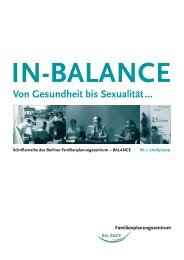with the country presenting the highest immigrant number(Ghana) down <strong>to</strong> the countries with lower immigrantnumbers.5.5.1. Ghana5.5.1.1. Socio-demographic profileAs illustrated in section 5.1, the Ghanaian community presentsalmost half (47%) of the immigrant population frompracticing countries from Sub-Saharan Africa in Hamburg.The distribution of men and women is quite balanced althoughthe number of registered women is higher.The Ghanaian community was easily accessible <strong>to</strong> the interviewersduring the qualitative and the quantitative phaseand we managed <strong>to</strong> reach a representative sample size: 263women and 254 men adding up <strong>to</strong> a <strong>to</strong>tal of 518 subjectsinterviewed.The average duration of stay of the participants of Ghanianorigin is about 15 years; many of the interviewees had beenin Germany for more than 25 years and had raised theirchildren outside of their country of origin. About one fourthof the participants were German passport holders. The largemajority (almost 97%) of the participants were Christians(see table 14).5.5.1.2. Proportion of immigrant population concernedThe overall FGM/C prevalence in Ghana is low. Practicinggroups are mainly found in the Upper West (56%) and theUpper East region (13%) (see map in annex 8.7), but as aresult of awareness raising campaigns, studies have reporteda progressive decline (Oduro, Ansah et al. 2006). FGM/C isunknown <strong>to</strong> ethnic groups living in the five southern regionsand is only practiced by migrant groups from the northeasternand north-western parts and from neighbouringcountries such as Mali, Burkina Faso or Togo (Planned ParenthoodAssociation 1998; US. Department of State 2001).Table 14: Socio-demographic characteristics of immigrants from GhanaSocio-demographicvariableswomen(n = 264)men(n = 254)<strong>to</strong>tal sample(n = 518)Age (in years)Mean (standard deviation) 35.9 (11.4) 39.8 (11.7) 37.8 (11.7)Range 16-71 16-71 16-71Average education level (in years)Mean (standard deviation) 12.7 (4.5) 14.2 (4.0) 13.5 (4.3)Range 0-25 0-25 0-25ReligionMuslim 18 (7%) 41 (16.5%) 59 (11.7%)Christian 232 (90.3%) 199 (79.9%) 431 (96.8%)None believers 7 (2.7%) 9 (3.6%) 16 (3.2%)Social statusMarried (monogamous) 104 (40.8%) 116 (46.4%) 220 (43.6%)Married (polygamous) 7 (2.7%) 14 (5.6%) 21 (4.2%)Separated/divorced/ widow 35 (13.8%) 42 (16.8%) 77 (15.3%)Never been married 22 109 (42.8%) 78 (31.2%) 187 (37%)Migrated from a(n)Urban area 193 (84.6%) 192 (80.0%) 385 (82.3%)Rural area 35 (15.4%) 48 (20%) 83 (17.7%)Residence statusUnbefristet (indefinite residence permission) 85 (32.8%) 102 (41.1%) 187 (36.9%)Befristet (temporary residence permission) 75 (29%) 68 (27.4%) 143 (28.2%)Duldung (<strong>to</strong>leration) 12 (4.6%) 16 (6.5%) 28 (5.5%)Others/ no papers/ does not answer 12 (4.6%) 8 (3.2%) 20 (4.0%)German nationality 75 (29.0%) 54 (21.8%) 129 (24.9%)Time spent in Germany (in months)Mean (standard deviation) 174.7 (107.8) 174.1 (113.4) 174.4 (110.4)Range 6-480 0-420 0-480<strong>Listening</strong> <strong>to</strong> <strong>African</strong> <strong>Voices</strong> 37
In order <strong>to</strong> determine the proportion of the Ghanaian immigrantsample affected by FGM/C, we cross-analysed thefollowing variables:• area of residency in Ghana,• ethnic group affiliation,• FGM/C existence in the family of the participant and• Information of key informants.The data of the quantitative survey showed that the largemajority (88%) of the Ghanaian immigrants comes from thefive southern regions. The highest proportion comes fromthe Ashanti region (see figure below). A further 11% comefrom the Brong Ahafo and the Northern region where prevalencerates are higher but still below 6%. Within our sample,only two participants came from the Upper West and fivefrom the Upper East region.Figure 5: Region of origin of immigrant sample from Ghana6.3 %Northern Region4.3 %Brong-Ahafo Region49.9 %Ashanti Region1.0 %Upper East Region0.4 %Upper West Region1.2 %Missing Data4.1 %Western RegionProportionof immigrantsfrom6.7 %Central Region16.8 %Greater Accra Region2.5 %Volta Region6.9 %Eastern RegionThe ethnic groups known for practicing FGM/C in Ghanaare the Busanga, Frafra, Kan<strong>to</strong>nsi, Kassena, Kussasi, Mamprusie,Moshie and Nankanne in the Upper East region andDargarti, Grunshie, Kan<strong>to</strong>nsi, Lobi, Sissala and Walas inthe Upper West region (Rahman and Toubia 2000; Hashi2001). The Ko<strong>to</strong>koli migrants from Togo and the Mossi fromBurkina Faso are also strong adherents of FGM/C.In our interviewed sample, most participants were affiliatedwith non-practicing ethnic groups, mostly the Ashanti(42.1%), Akan (15.6%), Fanti (6.8%), Ewe (5.0%) andthe Ga (7.5%). All <strong>to</strong>gether, over 87% of the participantscame from non-practicing groups. About further 5% of theparticipants came from rather small ethnic groups for whichwe could not find any documentation on FGM/C. Only 36persons (7.5%), 7 women and 29 men, were from practicingethnic groups 24 : the Busanga (2), Mamprusi (2), Frafra (2),Hausa (20), Hausa/Ashanti (1), Hausa/Ga (1), Hausa/Twi (1),Ko<strong>to</strong>koli (2), Hausa/Dendi (1), Hausa/Mossi (1), Hausa/Ko<strong>to</strong>koli(2) and Mossi (1). The key informants confirmed theseresults and one man summarised the situation as follows:“In Hamburg, the biggest group are the Ashanti. Thereare also some Ewe, Ga and Brong. The Northeners areonly very few. The Northeners go more <strong>to</strong> the USA. Thereis one group that is known for practicing this FGM, theFrafra. They are mostly poorly educated. As far as I know,there is no more than a handful in Hamburg.” (key informan<strong>to</strong>f Ghanaian origin)We asked all participants if they were from a group thatpracticed FGM/C and if the practice has taken place in theirfamily. About 12% of the participant confirmed that FGM/Cexisted in their group and about 7% responded positivelyabout its existence in their family.5.5.1.3. Women and girls concernedOut of the 264 women interviewed, 15 (5.7%) reportedhaving undergone FGM/C. Three women (1.2%) decidednot <strong>to</strong> answer the question. The remaining majority (93.1%)answered in the negative <strong>to</strong> the question. The 15 womenconcerned were between 24 and 61 years of age with anaverage age of 41; ten of them were Muslims, the other fivewere Christians. All but one came from the Northern andthe Upper East region. The described types indicate typeI or type II procedures. Five of the women had undergoneFGM/C during infancy and five more between 5 <strong>to</strong> 8 yearsold. Three women claimed <strong>to</strong> have been subjected <strong>to</strong> thepractice during their adolescence (around 15 years). Twowomen could not remember at what age they underwentFGM/C. All women reported that the practice had beenperformed in Ghana by traditional practitioners.We asked all participants if they had one or more daughtersand if yes, how many and where she/they lived. We thenascertained if and how many of the daughters had undergoneFGM/C or if the parent had the intention of subjectinga daughter <strong>to</strong> the practice.The participant sample of the Ghanaian community reporteda <strong>to</strong>tal of 439 daughters, 335 of them living in Hamburg. A<strong>to</strong>tal of 11 daughters had been subjected <strong>to</strong> FGM/C. All ofthese girls were living in Ghana and had never been <strong>to</strong> Germany.They belong <strong>to</strong> Muslim families, had been subjected<strong>to</strong> the practice at the hands of a traditional practitioner andwere between 0 <strong>to</strong> 8 years old. Furthermore, two partici-24 If a participant had one parent from a practicing and one parentfrom a non-practicing group, s/he was categorised in thepracticing groups.38<strong>Listening</strong> <strong>to</strong> <strong>African</strong> <strong>Voices</strong>






